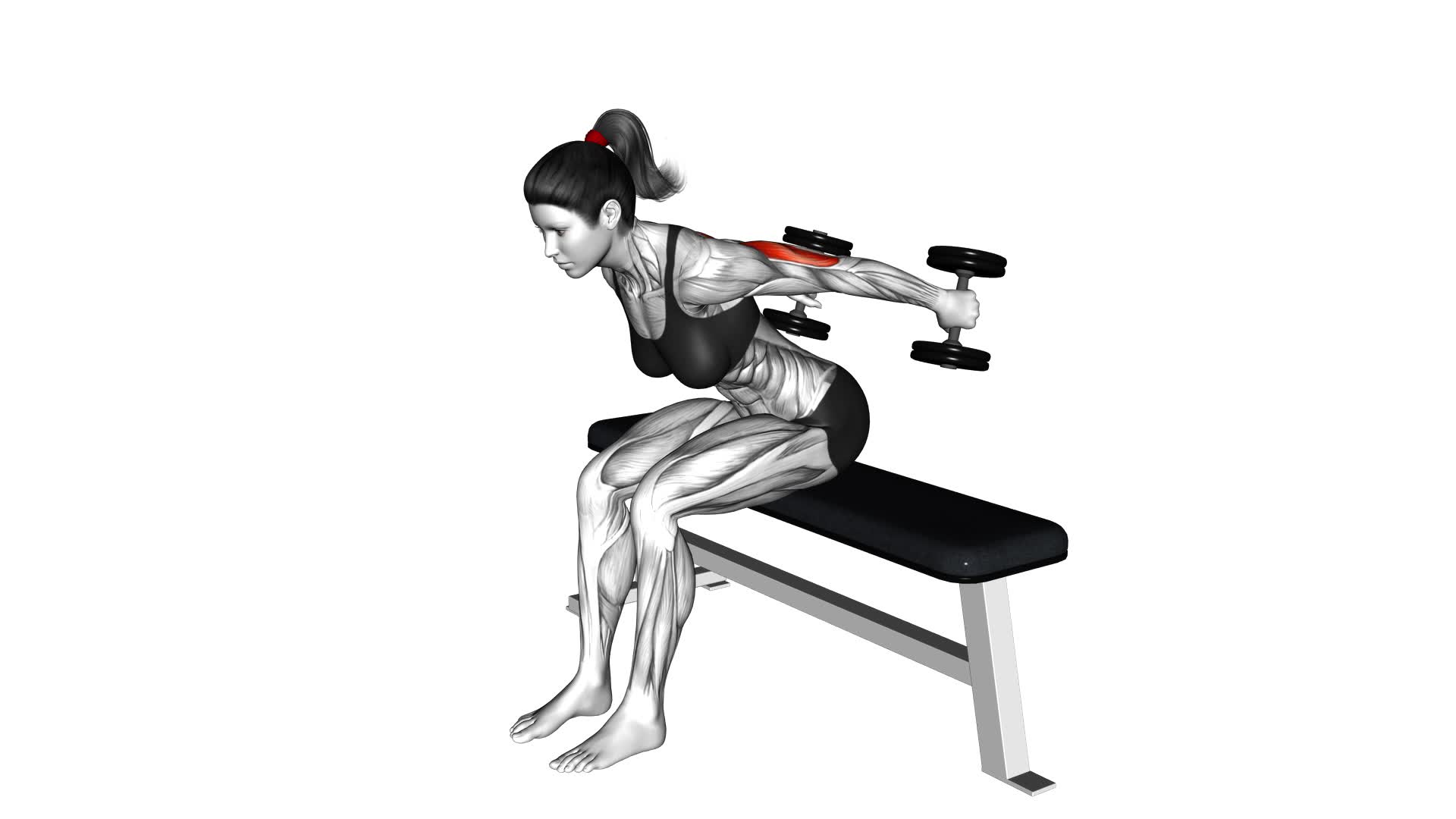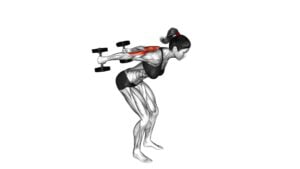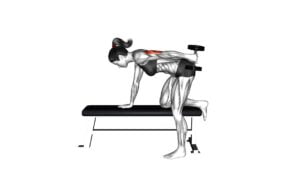Dumbbell Seated Kickback (female) – Video Exercise Guide & Tips

Looking to tone your triceps and sculpt those arms? The dumbbell seated kickback is the perfect exercise for you.
Watch This Exercise Video
In this video exercise guide, you'll discover the benefits of this move, learn how to properly set up and perform it, and get tips for maximizing your results.
Say goodbye to flabby arms and hello to strong, defined muscles. Get ready to kick it up a notch with this effective and empowering workout.
Let's get started!
Key Takeaways
- Increased muscle tone and strength in triceps and core
- Activation and strengthening of specific muscle groups
- Targeting and sculpting of the three heads of the triceps
- Engagement of core muscles for stability and improved posture
Benefits of the Dumbbell Seated Kickback
You can experience increased muscle tone and strength in your triceps and core by performing the dumbbell seated kickback exercise. This exercise is a great way to activate and strengthen these specific muscle groups. By holding a dumbbell in one hand and sitting on a bench or chair, you can isolate the triceps and engage your core for stability.
The primary muscle activated during the dumbbell seated kickback is the triceps. This exercise specifically targets the three heads of the triceps, helping to sculpt and define the back of your arms. As you extend your arm backwards, you'll feel a deep contraction in your triceps, which is a sign that the muscle is working hard.
In addition to targeting the triceps, the dumbbell seated kickback also engages your core muscles. Your core acts as a stabilizer throughout the exercise, helping you maintain proper form and balance. This not only strengthens your core, but also helps improve your overall stability and posture.
To add variation to your workout routine, you can try different variations of the dumbbell seated kickback. This can include using different weights, changing your hand position, or performing the exercise on an incline bench. These variations can help target different areas of the triceps and challenge your muscles in new ways.
Incorporating the dumbbell seated kickback into your fitness routine can lead to increased muscle tone and strength in your triceps and core. Consistency and proper form are key, so make sure to start with lighter weights and gradually increase the intensity as you become more comfortable. Remember to always listen to your body and modify the exercise as needed.
Proper Equipment and Set Up
To properly perform the dumbbell seated kickback exercise, you'll need a set of dumbbells and a sturdy bench or chair. Make sure to choose a weight that challenges you but still allows for proper form.
When setting up, sit on the bench with your feet flat on the floor and hold the dumbbells in your hands with your palms facing inwards.
Necessary Equipment for Setup
To properly set up for the dumbbell seated kickback exercise, always ensure that you have the necessary equipment in place. Here are the three essential items you'll need:
- Dumbbells: Choose a weight that challenges you but still allows for proper form. Start with a lighter weight if you're a beginner and gradually increase as you get stronger. It's important to find the optimal weight for your fitness level to maximize the effectiveness of the exercise.
- Exercise Bench: Find a sturdy bench that provides stability and support. Adjust the height to a comfortable position that allows your feet to touch the ground and maintain proper alignment throughout the movement.
- Mat: Place a mat under your knees for added comfort and support. This will help prevent any discomfort or strain on your joints during the exercise.
Correct Form and Alignment
To ensure proper form and alignment during the dumbbell seated kickback exercise, it's essential to have the correct equipment and set up in place.
First, choose dumbbells that are appropriate for your fitness level and grip them firmly with your hands.
Sit on a sturdy bench with your feet flat on the ground and your back straight. Place your hands at your sides with your palms facing inward. Keep your elbows close to your body throughout the exercise.
As you extend your arms backward, focus on contracting your triceps and squeezing them at the top of the movement. Avoid swinging your arms or using momentum to lift the dumbbells.
Remember, variations of this exercise exist, such as using resistance bands or performing the kickbacks on an incline bench.
Step-by-Step Guide for Performing the Exercise
Start by sitting on a bench with a dumbbell in each hand. This exercise primarily targets the triceps, which are the muscles on the back of your upper arms. However, it also engages the shoulders and the core muscles for stability.
To progress and increase difficulty in the dumbbell seated kickback exercise, you can follow these tips:
- Increase the weight: Gradually increase the weight of the dumbbells to challenge your muscles and promote strength gains. Start with a weight that allows you to perform the exercise with proper form, and gradually increase it as you become stronger.
- Increase the repetitions: Instead of increasing the weight, you can also increase the number of repetitions you perform. This helps build endurance in the targeted muscles.
- Slow down the movement: Slowing down the movement can make the exercise more challenging. Take your time to extend your arms fully during the kickback and then slowly lower the dumbbells back to the starting position. This increases the time under tension for your muscles, leading to greater muscle activation and growth.
Remember to maintain proper form and control throughout the exercise. With consistency and progressive overload, you can continuously challenge your muscles and achieve your fitness goals.
Common Mistakes to Avoid
Are you aware of the common mistakes to avoid when performing the dumbbell seated kickback exercise? Proper form and alignment are crucial to maximizing the benefits of this exercise while minimizing the risk of injury. By avoiding these common mistakes, you can ensure that you're getting the most out of your workout.
One common mistake is using too heavy of a weight. It's important to start with a weight that you can comfortably lift and control throughout the movement. Using weights that are too heavy can compromise your form and increase the risk of injury.
Another mistake isn't maintaining proper form and alignment. When performing the dumbbell seated kickback, it's important to keep your back straight, shoulders relaxed, and core engaged. Avoid rounding your back or hunching your shoulders, as this can put unnecessary strain on your spine and shoulders.
Additionally, many people tend to rush through the exercise, sacrificing proper form for speed. It's important to perform each repetition with control and focus on the muscles you're targeting. Slow, controlled movements will engage the targeted muscles more effectively and reduce the risk of injury.
Tips for Maximizing Results
To get the most out of your dumbbell seated kickback exercise and maximize your results, focus on these tips:
- Increase the Intensity: To maximize your results, it's important to continually challenge your muscles. Gradually increase the weight of the dumbbells you use for the seated kickback exercise. This will help to build strength and tone your triceps effectively. Additionally, you can also try increasing the number of sets and repetitions you perform, or incorporate supersets and drop sets into your routine to further intensify the exercise.
- Vary the Angle: To avoid hitting a plateau and keep your muscles guessing, try changing the angle of your seated kickbacks. Instead of keeping your upper arms parallel to the ground, experiment with different positions, such as keeping your upper arms slightly higher or lower. This variation will target your triceps from different angles, stimulating muscle growth and preventing stagnation.
- Maintain Proper Form: While it's important to challenge yourself, it's equally important to maintain proper form throughout the exercise. Avoid swinging your arms or using momentum to lift the weights. Instead, focus on isolating your triceps and moving only at the elbow joint. By maintaining strict form, you'll ensure that your triceps are doing the majority of the work, maximizing the effectiveness of the exercise and minimizing the risk of injury.
Alternative Exercises to Try
Looking to switch up your workout routine and target different muscle groups? Try incorporating some effective alternative exercises into your fitness regimen.
By adding variety to your workouts, you can challenge your body in new ways and prevent plateauing.
Whether it's incorporating resistance bands, using cables, or trying different variations of the kickback exercise, there are plenty of options to keep your muscles guessing and maximize your results.
Effective Alternatives for Variety
Try incorporating different exercises into your routine to keep things fresh and challenging. Here are some effective alternatives to the dumbbell seated kickback that you can try for variety and to target different muscle groups:
- Resistance band kickbacks: Attach a resistance band to a stationary object and loop it around your ankle. Stand facing the anchor point and kick your leg back, squeezing your glutes at the top of the movement.
- Cable kickbacks: Attach an ankle cuff to a cable machine and position yourself facing away from the machine. With your feet hip-width apart, kick your leg back while keeping your core engaged.
- Bodyweight kickbacks: Get down on all fours with your hands directly under your shoulders and your knees under your hips. Extend one leg straight back, squeezing your glutes, and then return to the starting position.
Targeting Different Muscle Groups
Switch up your workout routine and target different muscle groups with these alternative exercises. By incorporating variations of exercise, you can activate different muscles and prevent plateaus in your fitness journey.
One alternative exercise to try is the dumbbell bicep curl. This exercise primarily targets the biceps, but also engages the forearm muscles. Simply stand with a dumbbell in each hand, palms facing forward, and curl the weights towards your shoulders while keeping your elbows close to your body.
Another effective exercise is the barbell deadlift. This compound movement targets multiple muscle groups including the glutes, hamstrings, and lower back. To perform this exercise, stand with your feet shoulder-width apart, grip the barbell with an overhand grip, and lift the barbell by extending your hips and pushing your knees forward.
Incorporating these alternative exercises into your workout routine will help you achieve a well-rounded physique and maximize muscle activation.
Frequently Asked Questions
How Many Sets and Reps Should I Do for the Dumbbell Seated Kickback?
To get the most out of your dumbbell seated kickback, it's important to know how many sets and reps to do.
The dumbbell seated kickback benefits your triceps and helps sculpt your arms.
For optimal results, aim for 3-4 sets of 10-12 reps. This will challenge your muscles and help increase strength and definition.
Remember to maintain proper form throughout the exercise to avoid common mistakes in dumbbell seated kickback.
Stay focused and push yourself to reach your fitness goals!
Can I Perform the Dumbbell Seated Kickback if I Have a Previous Shoulder Injury?
If you have a previous shoulder injury, it's important to be cautious when performing the dumbbell seated kickback.
While it can be a great exercise for targeting the triceps, there are alternative exercises that can help with your shoulder injury recovery.
Consult with a healthcare professional or a qualified trainer to find exercises that are safe and effective for you.
Don't let your injury discourage you, there are plenty of options to keep you on track towards your fitness goals.
Is It Better to Use Lighter or Heavier Dumbbells for the Dumbbell Seated Kickback?
When it comes to the dumbbell seated kickback, the weight of the dumbbells you choose can make a difference.
Using lighter dumbbells allows for more repetitions, helping to build muscular endurance.
On the other hand, heavier dumbbells can provide a greater challenge, leading to increased strength and muscle growth.
Ultimately, the choice between lighter or heavier dumbbells depends on your fitness goals and current strength level.
Incorporating dumbbells into your seated kickbacks can offer a variety of benefits, such as targeting and strengthening the triceps effectively.
Can I Incorporate the Dumbbell Seated Kickback Into a Full-Body Workout Routine?
Yes, you can definitely incorporate the dumbbell seated kickback into your full-body workout routine. This exercise targets your triceps, helping to strengthen and tone them. It also engages your core for stability.
If you're looking for alternatives, you can try tricep pushdowns or dips. Incorporating the dumbbell seated kickback will add variety to your routine and help you achieve a well-rounded workout.
Plus, the benefits of stronger triceps include improved upper body strength and aesthetics. Keep pushing yourself!
Are There Any Modifications or Variations of the Dumbbell Seated Kickback for Beginners?
When starting out with the dumbbell seated kickback, it's important to focus on modifications for beginners.
This exercise can be challenging, so start with lighter weights and gradually increase as you get stronger.
Keep your back straight and engage your core to avoid common mistakes like rounding your back or swinging the weights.
Remember to maintain proper form and control throughout the movement for maximum effectiveness and to prevent injury.
You got this!
Conclusion
Incorporating the dumbbell seated kickback into your workout routine can provide numerous benefits, including strengthening and toning your triceps.
By following the proper equipment set up and performing the exercise correctly, you can maximize your results and avoid common mistakes.
Remember to focus on form and challenge yourself with alternative exercises to continually progress.
Stay dedicated and motivated, and you'll see the desired results in no time.
Keep pushing yourself towards your fitness goals!

Author
Years ago, the spark of my life’s passion ignited in my mind the moment I stepped into the local gym for the first time. The inaugural bead of perspiration, the initial endeavor, the very first surge of endorphins, and a sense of pride that washed over me post-workout marked the beginning of my deep-seated interest in strength sports, fitness, and sports nutrition. This very curiosity blossomed rapidly into a profound fascination, propelling me to earn a Master’s degree in Physical Education from the Academy of Physical Education in Krakow, followed by a Sports Manager diploma from the Jagiellonian University. My journey of growth led me to gain more specialized qualifications, such as being a certified personal trainer with a focus on sports dietetics, a lifeguard, and an instructor for wellness and corrective gymnastics. Theoretical knowledge paired seamlessly with practical experience, reinforcing my belief that the transformation of individuals under my guidance was also a reflection of my personal growth. This belief holds true even today. Each day, I strive to push the boundaries and explore new realms. These realms gently elevate me to greater heights. The unique combination of passion for my field and the continuous quest for growth fuels my drive to break new ground.







